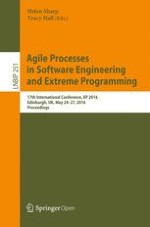1 Introduction and Aim of the Research
-
RQ1: Is the continuous application of a SQA tool (SonarQube) applicable to agile development processes?
-
RQ2: Does the continuous application of a SQA tool (SonarQube) help to improve the developers’ awareness of code smells in agile processes?
2 Background and Related Work
3 The Case Study
-
analyze the continuous application SonarQube
-
for the purpose of evaluating and comparing
-
with respect to applicability and the code smells awareness
-
from the point of view of the developers
-
in the context of agile software development.
3.1 Data Collection Methods
-
“I learned which kind of code smells I usually introduce in the source code.”
-
“The report pointed out code smells I was not aware of.”
-
“The identified code smells do not make sense.”
-
“The effort required to analyze the report is too high compared to the provided benefits.”
-
“It was easy for me to understand how the approach works.”
-
“It was easy for me to decide to remove the code smell or not, based on the information provided by the tool.”
-
“It was easy for me to identify the code smell.”
-
“After using the tool I was able to remember previous code smells and how to not introduce them anymore.”
-
“The approach helped me to increase my productivity reducing refactoring time.”
